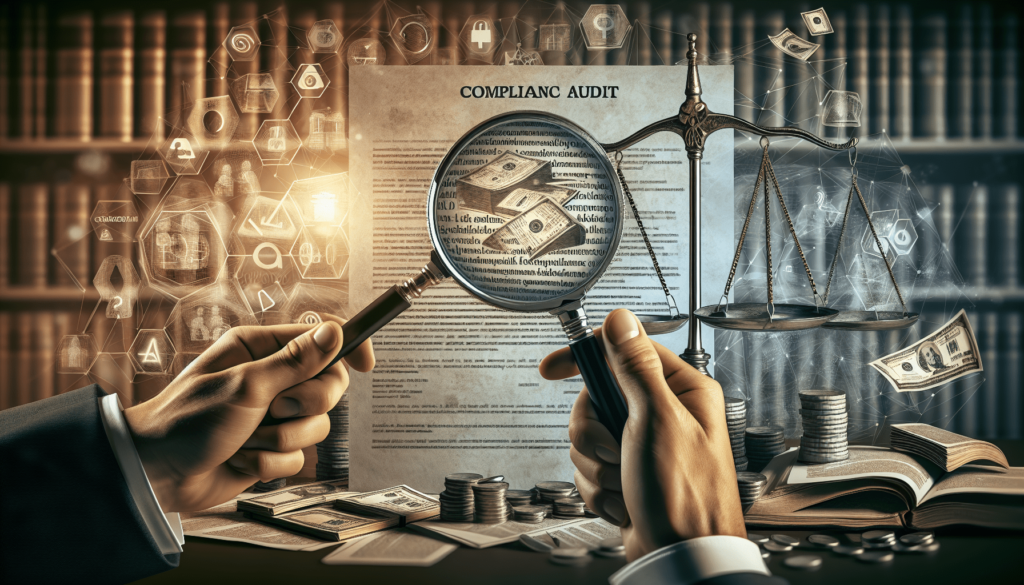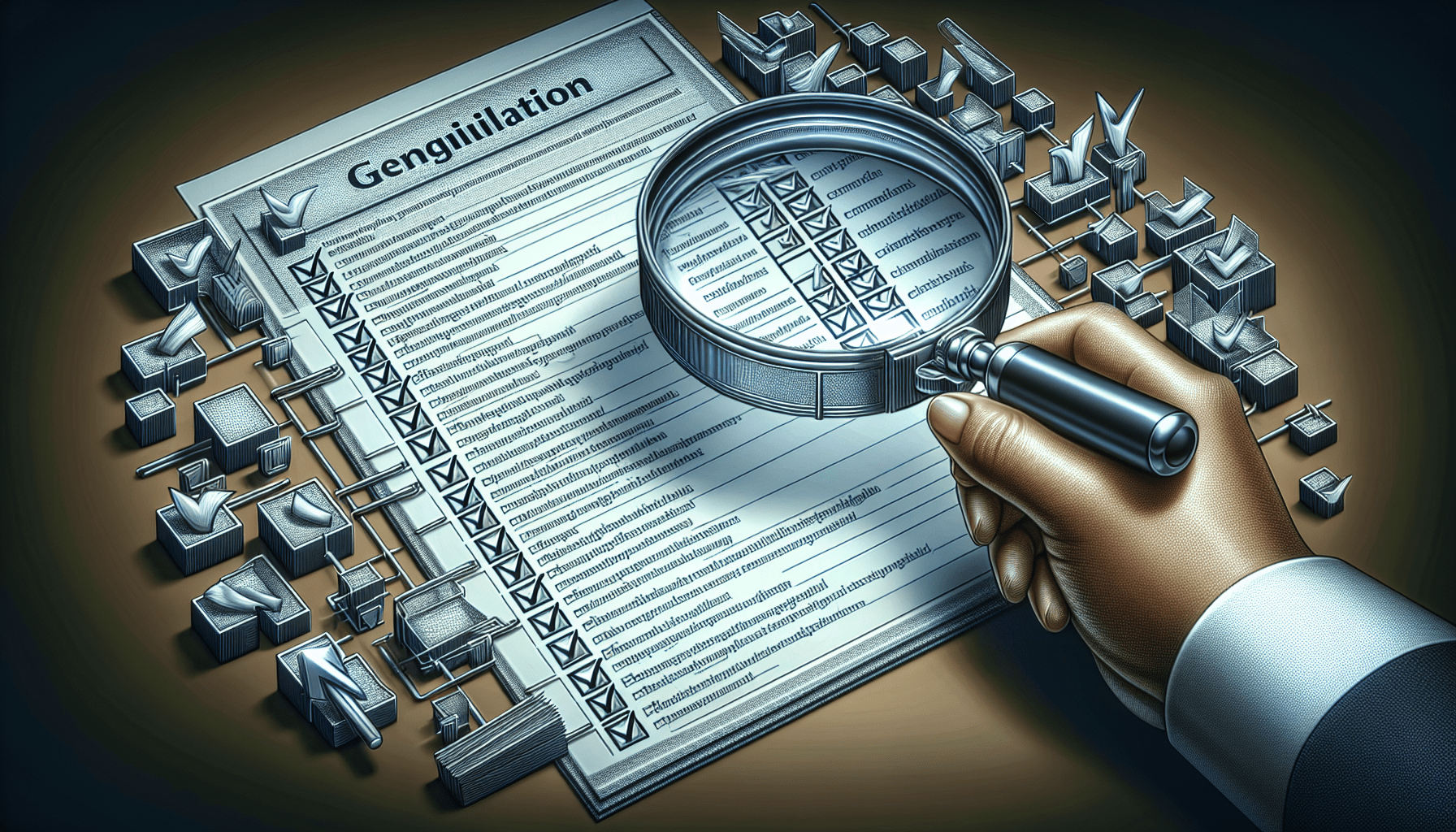In the world of compliance audits, one wrong move can lead to significant consequences for organizations. To ensure a smooth and successful audit process, it is crucial to be well-versed in the common mistakes that can undermine the effectiveness of these audits. This article will highlight some of the key errors that organizations often make during compliance audits, providing valuable insights for professionals in the field. By understanding and avoiding these mistakes, you can strengthen your compliance procedures and bolster your organization’s overall risk management framework.
Inadequate Planning
Failure to set clear objectives for the audit
One common mistake in compliance audits is the failure to establish clear objectives. Without clearly defined objectives, the audit process may lack focus and direction, leading to inefficient use of resources and potentially missing important compliance issues. Setting specific and measurable objectives allows for a more effective and targeted audit, ensuring that all necessary areas of compliance are addressed.
Lack of proper documentation and audit plan
Another mistake is the lack of proper documentation and an audit plan. Documentation plays a crucial role in compliance audits as it provides a record of the audit process and serves as evidence of compliance efforts. Without proper documentation, it becomes challenging to track the audit’s progress, identify any gaps or deficiencies, and ensure accountability. Additionally, an audit plan outlines the scope, objectives, and procedures of the audit, providing a roadmap for the auditors and ensuring a systematic and structured approach to the audit process.
Insufficient allocation of resources and time
Inadequate allocation of resources and time can also hinder the effectiveness of compliance audits. Without allocating enough resources, such as personnel, technology, and tools, the audit team may struggle to gather and analyze the necessary data, increasing the risk of overlooking compliance issues. Similarly, insufficient time allocation can result in rushed audits, leading to oversight of critical areas or inadequate testing, ultimately undermining the accuracy and reliability of the audit findings.
Lack of Understanding of Regulatory Requirements
Failure to stay updated with changes in regulations
A significant mistake in compliance audits is the failure to stay updated with changes in regulations. Regulatory requirements are constantly evolving, and organizations must remain aware of any changes that may impact their compliance obligations. Failing to stay updated can lead to non-compliance, as auditors may not be aware of new obligations or changes in interpretation. It is crucial for audit teams to regularly monitor and review regulatory updates to ensure they are adequately informed during the audit process.
Misinterpretation of compliance requirements
Misinterpreting compliance requirements is another common mistake that auditors should avoid. The complexity and ambiguity of regulations can make it challenging to fully understand and interpret compliance requirements. However, misinterpretation can result in audit findings that do not accurately reflect the organization’s compliance status. To mitigate this risk, auditors should seek clarification, consult subject matter experts, and refer to guidance documents or regulatory resources to ensure a correct understanding of compliance requirements.
Lack of knowledge about industry-specific regulations
Furthermore, lack of knowledge about industry-specific regulations can undermine the effectiveness of compliance audits. Different industries may have unique regulations and requirements that auditors need to be familiar with to adequately assess compliance. Without a thorough understanding of these industry-specific regulations, auditors may miss critical compliance issues or fail to apply the appropriate assessment criteria. To address this, audit teams should invest in industry-specific training and stay informed about any changes or updates specific to their sector.

Failure to Conduct Adequate Risk Assessment
Neglecting to identify and assess potential compliance risks
One critical mistake in compliance audits is neglecting to identify and assess potential compliance risks. Risk assessment plays a pivotal role in determining the areas that require closer scrutiny during the audit. Failing to identify and assess these risks can result in oversight of high-risk areas, leaving the organization vulnerable to compliance breaches. It is essential to conduct a comprehensive risk assessment to identify, evaluate, and prioritize potential compliance risks appropriately.
Not considering the impact and likelihood of identified risks
In addition to identifying and assessing potential compliance risks, auditors must also consider the impact and likelihood of these risks occurring. Failing to account for these factors can result in inaccurate risk prioritization, leading to a disproportionate allocation of resources or insufficient focus on critical risks. By evaluating the potential impact and likelihood of identified risks, auditors can allocate resources effectively and prioritize the areas of highest compliance risk.
Overlooking emerging risks and new compliance challenges
Auditors must also be vigilant in identifying emerging risks and new compliance challenges. Regulatory landscapes are constantly evolving, and new risks may emerge that require attention. Ignoring emerging risks can leave organizations unprepared to address potential compliance breaches. Auditors should stay informed about industry trends, regulatory updates, and other relevant sources to ensure they are aware of any new compliance challenges. Actively addressing emerging risks ensures that the audit remains relevant and proactive in identifying and mitigating potential compliance issues.
Ineffective Communication and Reporting
Poor communication between the audit team and stakeholders
Poor communication is a common mistake that can impede the effectiveness of compliance audits. Effective communication between the audit team and stakeholders is crucial to ensure the audit process runs smoothly and that all parties are well-informed. Failure to communicate clearly and promptly can lead to misunderstandings, delays, and a lack of collaboration. It is essential for auditors to establish clear channels of communication, provide regular updates to stakeholders, and address any concerns or questions promptly and professionally.
Unclear and inconsistent reporting of audit findings
Another mistake is providing unclear and inconsistent reporting of audit findings. The purpose of the audit report is to communicate the results of the audit and provide recommendations for improvement. However, if the report is not clear, concise, and consistent, it can lead to confusion and difficulty in understanding the audit findings and recommendations. Auditors should strive to use clear and precise language, provide sufficient detail without overwhelming the reader, and ensure consistency in reporting across different sections of the audit report.
Failure to present recommendations in a clear and actionable manner
Auditors must also ensure that their recommendations are presented in a clear and actionable manner. Providing vague or impractical recommendations can hinder an organization’s ability to implement necessary changes and improve compliance. Recommendations should be specific, realistic, and tailored to the organization’s unique circumstances. Auditors should consider the organization’s resources, capabilities, and constraints when formulating recommendations to increase the likelihood of successful implementation.

Insufficient Audit Testing
Inadequate sample size for testing compliance controls
Insufficient sample size for testing compliance controls is a critical mistake that auditors must avoid. A small sample size may not provide a representative view of an organization’s compliance practices, potentially overlooking non-compliance issues. By using an inadequate sample size, auditors may not be able to assess the effectiveness of controls accurately. It is crucial to determine an appropriate sample size based on statistical sampling methods and the specific nature of the compliance controls being evaluated.
Lack of comprehensive and independent testing procedures
Another common mistake is the lack of comprehensive and independent testing procedures. Audit testing should be comprehensive, covering all relevant compliance areas and activities. Failing to test all controls increases the risk of undetected compliance breaches. Additionally, auditors should strive for independence and objectivity in their testing procedures to ensure a fair assessment of compliance. Independence helps to validate the accuracy and reliability of the audit findings.
Failure to perform substantive testing of compliance data
Failure to perform substantive testing of compliance data is also a significant mistake that can compromise the quality of the audit. Substantive testing involves verifying the accuracy and completeness of compliance data and documentation. By neglecting substantive testing, auditors may rely solely on controls testing, which may not always reveal errors or oversights in compliance practices. A combination of controls testing and substantive testing provides a more comprehensive and reliable assessment of an organization’s compliance.
Neglecting Recordkeeping and Documentation
Inadequate recordkeeping of audit procedures and findings
Neglecting to maintain adequate records of audit procedures and findings can undermine the effectiveness of compliance audits. Records provide evidence of the audit’s scope, procedures, and conclusions, enabling auditors to demonstrate the thoroughness and reliability of their work. Inadequate recordkeeping can lead to challenges in defending audit findings, addressing queries, or conducting follow-up activities. It is essential for auditors to establish robust recordkeeping practices, ensuring that all relevant information and evidence are properly documented and retained.
Failure to maintain evidence of compliance efforts
Alongside recordkeeping, auditors must ensure the maintenance of evidence demonstrating an organization’s compliance efforts. Without documented evidence, it becomes challenging to validate compliance claims and demonstrate ongoing adherence to regulatory requirements. Auditors should prioritize obtaining and preserving evidence of compliance efforts, such as training records, policies, procedures, and correspondence with regulatory bodies. A comprehensive record of compliance efforts strengthens the audit’s credibility and provides assurance to stakeholders that the organization is actively committed to compliance.
Inconsistency in documentation practices
Consistency in documentation practices is crucial for effective compliance audits. Inconsistency can lead to confusion, inaccuracies, and challenges in retrieving and comparing information during the audit process. Auditors should establish standardized documentation practices, including templates, formatting guidelines, and naming conventions. Consistency in documentation not only improves efficiency but also ensures clarity and accuracy in the audit process.
Ignoring Whistleblower and Internal Reporting Mechanisms
Not considering the effectiveness of internal reporting systems
Neglecting to consider the effectiveness of internal reporting systems is a significant mistake auditors should avoid. Internal reporting mechanisms, such as whistleblower hotlines or anonymous reporting channels, play a crucial role in identifying potential compliance issues. Ignoring the effectiveness of these systems can result in overlooked compliance concerns or instances of misconduct. Auditors should assess the functionality, accessibility, and responsiveness of internal reporting mechanisms to ensure they provide a reliable and effective channel for reporting compliance concerns.
Neglecting the review of whistleblower complaints
Related to internal reporting mechanisms, auditors must not disregard the review of whistleblower complaints. Whistleblower complaints can provide valuable insights into potential compliance breaches or systemic issues within an organization. By neglecting to review and follow up on whistleblower complaints, auditors may miss critical information that could significantly impact the audit findings. Auditors should establish procedures for reviewing and investigating whistleblower complaints, ensuring that all relevant information is considered during the audit process.
Failure to investigate and document reported compliance concerns
Lastly, auditors must ensure that reported compliance concerns are appropriately investigated and documented. Failing to investigate reported concerns can undermine the credibility of the audit and erode trust within the organization. It is crucial for auditors to conduct thorough and impartial investigations, incorporating evidence-gathering, analysis, and documentation of findings. By addressing reported concerns promptly and documenting the investigative process, auditors demonstrate their commitment to a robust and comprehensive audit.
Limited Focus on Ethics and Corporate Culture
Insufficient consideration of ethical behavior and corporate values
Limited focus on ethics and corporate culture is a common mistake in compliance audits. Compliance is not solely about meeting regulatory requirements; it also encompasses ethical behavior and adherence to corporate values. Neglecting to consider these aspects can result in an incomplete assessment of an organization’s compliance status. Auditors should evaluate the organization’s ethical standards, code of conduct, and overall corporate culture to ensure alignment with regulatory requirements and ethical expectations.
Neglecting the assessment of compliance culture within the organization
Alongside corporate culture, auditors must assess the compliance culture within the organization. Compliance culture refers to the extent to which compliance is embedded and emphasized throughout the organization. Neglecting this assessment can lead to a superficial understanding of an organization’s commitment to compliance. Auditors should evaluate the organization’s tone from the top, the effectiveness of compliance training and communication, and the accountability mechanisms in place to promote a strong compliance culture.
Failure to address ethical issues and potential conflicts of interest
Failure to address ethical issues and potential conflicts of interest undermines the effectiveness of compliance audits. Ethical issues and conflicts of interest can significantly impact an organization’s compliance practices and reputation. Auditors must actively identify and assess potential ethical concerns, ensuring they are adequately addressed and mitigated. By addressing ethical issues and conflicts of interest, auditors contribute to the organization’s ethical integrity and strengthen its overall compliance framework.
Inadequate Staff Training and Awareness
Lack of training programs on compliance standards and regulations
Neglecting to provide training programs on compliance standards and regulations is a significant mistake that can hinder compliance audits. Without proper training, employees may lack awareness of their compliance responsibilities or the knowledge needed to adhere to regulatory requirements. Auditors should assess the organization’s training programs and identify any gaps or deficiencies. By providing comprehensive and regular training on compliance standards and regulations, organizations can foster a culture of compliance and enhance employees’ understanding of their role in ensuring compliance.
Failure to provide ongoing awareness and education for employees
Another mistake is failing to provide ongoing awareness and education for employees. Compliance requirements are dynamic and subject to change, requiring employees to stay informed and updated regularly. Without ongoing awareness initiatives, employees may miss important updates or fail to recognize evolving compliance risks. Auditors should encourage organizations to establish mechanisms for disseminating compliance-related information, such as newsletters, intranet updates, or training sessions. Ongoing awareness and education promote a proactive and informed approach to compliance within the organization.
Inadequate training on using compliance tools and systems
Lastly, auditors must ensure that employees receive adequate training on using compliance tools and systems. Compliance processes often rely on technology, such as compliance management systems or data analytics tools. Inadequate training on these tools and systems can hinder employees’ ability to effectively utilize them, limiting the efficiency and accuracy of compliance audits. Auditors should assess employees’ familiarity and proficiency with the necessary tools and systems, recommending additional training or support as needed to maximize their effectiveness in ensuring compliance.
Failure to Monitor and Follow-Up on Audit Findings
Not establishing a process for tracking and addressing audit findings
Failure to establish a process for tracking and addressing audit findings is a common mistake in compliance audits. Once the audit is completed, it is crucial to have a mechanism in place to monitor the progress of implementing audit recommendations and addressing any identified deficiencies. Without a process for tracking and addressing findings, there is a risk of non-compliance persisting or recurring. Auditors should work with organizations to establish a robust follow-up process, assigning responsibilities, setting timelines, and regularly reviewing the progress of corrective actions.
Lack of accountability for corrective actions
Another mistake is the lack of accountability for corrective actions. Without clear ownership and accountability, corrective actions may not be effectively implemented or monitored. The responsibility for corrective actions should be clearly assigned to individuals or teams, and their progress should be regularly reviewed and reported. Auditors should emphasize the importance of accountability to ensure that corrective actions are completed in a timely and satisfactory manner.
Inadequate monitoring of compliance improvements over time
Lastly, auditors must ensure that compliance improvements are adequately monitored over time. Compliance is an ongoing process, and organizations must regularly assess their compliance status to identify any areas that require further attention or improvement. Auditors should work with organizations to establish a system for monitoring compliance improvements, including periodic assessments or audits to evaluate the effectiveness of implemented changes. By proactively monitoring compliance improvements, organizations can continuously enhance their compliance frameworks and mitigate potential risks.
In conclusion, compliance audits can be challenging and complex, but by avoiding common mistakes, auditors can conduct more effective and valuable assessments. By setting clear objectives, staying updated on regulatory requirements, conducting adequate risk assessments, ensuring effective communication and reporting, performing comprehensive audit testing, maintaining proper recordkeeping and documentation, considering internal reporting mechanisms, focusing on ethics and corporate culture, providing staff training and awareness, and monitoring and following up on audit findings, auditors can enhance the accuracy, reliability, and impact of their compliance audits. By addressing these common mistakes, organizations can strengthen their compliance programs and mitigate the risk of non-compliance, promoting ethical behavior, and safeguarding their reputation.



